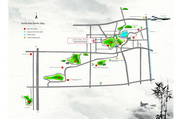Nine Peaks Temple2012-05-17
Nine Peaks Temple, located in the northern peak of small Kunshan Mountain, used to be Sizhou Pagoda Complex. It was built in the first year of Emperor Qiandao's reign in the Southern Song Dynasty (1165).
Lu Ji and Lu Yun's Reading Platform2012-05-17
Lu Ji and Lu Yun are the grandsons of Governor Lu Xun and Admiral Lu Kang of the Kingdom of Wu in the Three Kingdom Period. They were influential writers and calligraphers in the Western Jin Dynasty. Lu Ji and Lu Yun's Reading Platform, also known as Lu Ji and Lu Yun's Humble Cottage, is situated at the southern foot of Tianmashan.
368-step footpath2012-05-17
After stepping into the gate and crossing an orchid bamboo bridge, you will see a footpath leading to the mountain top.
Baishishan Pavilion2012-05-17
On the cliff of the southern peak of East Sheshan, there is a pavilion built on the original site of Baishishan House in memory of Chen Jiru.
Forest Café and Landscape Teahouse2012-05-17
In order to receive numerous visitors after East Sheshan Park was made freely open to the public, and raise the reputation of the park in tourism and leisure, two service outlets were built on the western slope of the northern peak: Forest Café and Landscape Teahouse.
Forest plank road2012-05-17
Forest plank road is a new attraction developed by East Sheshan Park. It starts from Baishishan Pavilion on the southern peak and stretches northwards along the eastern slope of the peak to Forest Café. The total length is about 270m.
Wooden Knocker Rock2012-05-17
Between the southern and northern peaks of East Sheshan, there is a natural rock. It looks like a wooden knocker used when monks chant Sutras.
Buddha Spring2012-05-17
Buddha Spring is in the ascending section of the ancient Emperor Qianlong path in East Sheshan after it makes a left turn.
Tianma Mountain Park2012-05-17
Tianmashan is also known as Ganshan. It got its name when Gan Jiang and Mo Ye cast swords here in the Spring and Autumn Period. As the mountain had many temples and worshipers, it is also called "Shaoxiangshan".
Huzhu Pagoda2012-05-17
Huzhu Pagoda is on the right of the middle peak of Tianmashan. It is a seven-story octagonal brick-wood structure and about 18.8m high.
Copyright ©
China Daily All Rights Reserved, Constructed by China Daily
Official Website of the Sheshan National Tourist Resort, Shanghai
Official Website of the Sheshan National Tourist Resort, Shanghai



